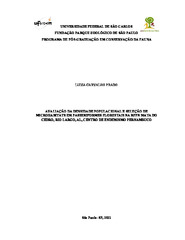| dc.contributor.author | Prado, Luiza Carvalho | |
| dc.date.accessioned | 2021-07-26T12:58:24Z | |
| dc.date.available | 2021-07-26T12:58:24Z | |
| dc.date.issued | 2021-05-26 | |
| dc.identifier.citation | PRADO, Luiza Carvalho. Avaliação da densidade populacional e seleção de microhabitats em passeriformes florestais na RPPN Mata do Cedro, Rio Largo, AL, Centro de Endemismo Pernambuco. 2021. Dissertação (Mestrado em Conservação da Fauna) – Universidade Federal de São Carlos, São Carlos, 2021. Disponível em: https://repositorio.ufscar.br/handle/ufscar/14667. | * |
| dc.identifier.uri | https://repositorio.ufscar.br/handle/ufscar/14667 | |
| dc.description.abstract | The Pernambuco Endemism Center (PEC) is an area of Atlantic Forest with high biodiversity levels due to biogeographic and historical factors. Located in Northeastern Brazil, north of the São Francisco River, the PEC is considered one of the most threatened regions on earth, being the most fragmented and degraded Atlantic Forest area in the entire biome. The PEC houses a series of endemic and endangered species, some of which are still in the process of being described. The classification of the levels of threat of the animals from the PEC in red lists have been based solely on their geographic distribution and areas of occurrence, especially because data on population density and population size estimates are unavailable. These estimates, when associated with studies on habitat selection and preference, can provide conservation managers with important information, useful to decide where and how to direct resources and efforts for conservation. In this work, population censuses estimates were carried out for five passerine species in one of the most representative PEC fragments from the state of Alagoas, using Distance sampling linear transects. All of the species are threatened with extinction and endemic to the PEC: the Pernambuco Fire-eye Pyriglena pernambucensis (VU), the Black-cheecked Gnateater Conopophaga melanops nigrifrons (VU), the White-shouldered Antshrike Thamnophilus aethiops distans (EN), the Brown-winged Mourner Schiffornis turdina intermedia (VU), and the White-bellied Tody-tyrant Hemitriccus griseipectus naumburgae (VU). Although four of the five taxa are included in the same threat category, population densities varied from 0.13 to 0.73 individuals per hectare, being P. pernambucensis the taxa with the lowest, and Hemitriccus g. naumburgae the species with highest population density estimate. Through extrapolation of the observed densities, it was possible to produce minimum population sizes estimates for these birds. Two of these taxa, belonging guild of the of the forest understory insectivorous passerines, also had their microhabitat preferences analyzed. For both, microhabitat selection was based on characteristics of the forest understory vegetation, indicating the importance of microhabitat heterogeneity. | eng |
| dc.description.sponsorship | Outra | por |
| dc.language.iso | por | por |
| dc.publisher | Universidade Federal de São Carlos | por |
| dc.rights | Attribution-NonCommercial-NoDerivs 3.0 Brazil | * |
| dc.rights.uri | http://creativecommons.org/licenses/by-nc-nd/3.0/br/ | * |
| dc.subject | Avifauna | por |
| dc.subject | Biodiversidade | por |
| dc.subject | Conservação | por |
| dc.subject | Espécies ameaçadas | por |
| dc.subject | Mata Atlântica | por |
| dc.subject | Atlantic Forest | eng |
| dc.subject | Biodiversity | eng |
| dc.subject | Conservation | eng |
| dc.subject | Endangered species | eng |
| dc.title | Avaliação da densidade populacional e seleção de microhabitats em passeriformes florestais na RPPN Mata do Cedro, Rio Largo, AL, Centro de Endemismo Pernambuco | por |
| dc.title.alternative | Population density assessment and microhabitats selection of forest passeriforms at RPPN Mata do Cedro, Rio Largo, AL, Pernambuco Endemism Center | eng |
| dc.type | Dissertação | por |
| dc.contributor.advisor1 | Francisco, Mercival Roberto | |
| dc.contributor.advisor1Lattes | http://lattes.cnpq.br/4305313620456233 | por |
| dc.description.resumo | O Centro de Endemismo Pernambuco (CEP) é uma área de Mata Atlântica com altos níveis de biodiversidade devido a fatores biogeográficos e históricos. Localizado no Nordeste do Brasil, ao norte do Rio São Francisco, o CEP é considerado uma das regiões mais ameaçadas do planeta, sendo a área de Mata atlântica mais fragmentada e degradada de todo o bioma. O CEP abriga uma série de espécies endêmicas e ameaçadas de extinção, algumas ainda em processo de descrição. A classificação do grau de ameaça da maioria das espécies do CEP em listas de espécies ameaçadas de extinção levou em consideração apenas as distribuições geográficas e as áreas de ocorrência dos taxa. Embora estimativas de densidade e de tamanhos populacionais sejam importantes para estas classificações, estes dados são inexistentes para estes animais. Estas estimativas, quando associadas a estudos de seleção e preferência de habitat geram ainda informações capazes de melhor direcionar recursos e esforços para a conservação. Neste trabalho foram realizados censos populacionais em um dos fragmentos de maior representatividade do Estado de Alagoas, através da metodologia de Distance sampling por transectos lineares, de cinco passeriformes florestais, ameaçados de extinção e endêmicos do CEP: o Papa-taoca-de-pernambuco Pyriglena pernambucensis (Vulnerável/VU), o Chupa-dente-de-máscara-preta Conopophaga melanops nigrifrons (VU), a Choca-da-mata Thamnophilus aethiops distans (Em perigo/ EN), o Flaltim-marrom Schiffornis turdina intermedia (VU), e a Maria-de-barriga-branca Hemitriccus griseipectus naumburgae (VU). Apesar de quatro dos cinco táxons estarem incluídos na mesma categoria de ameaça, as densidades populacionais encontradas variaram entre 0.13 e 0.73 indivíduos por hectare, sendo a espécie com menor densidade P. pernambucensis e maior H. griseipectus naumburgae. Através de extrapolações das densidades observadas foi possível produzir estimativas de tamanho populacional mínimo para as espécies estudadas. Dois destes táxons também tiveram suas preferências de microhabitat analisadas (P. pernambucensis and C. m. nigrifrons. Para ambos, características específicas relacionadas à vegetação do sub-bosque florestal foram selecionadas, demonstrando a importância da manutenção da heterogeneidade deste tipo de ambiente. | por |
| dc.publisher.initials | UFSCar | por |
| dc.publisher.program | Programa de Pós-Graduação em Conservação da Fauna - PPGCFau | por |
| dc.subject.cnpq | CIENCIAS BIOLOGICAS::ECOLOGIA | por |
| dc.subject.cnpq | CIENCIAS AGRARIAS::RECURSOS FLORESTAIS E ENGENHARIA FLORESTAL::CONSERVACAO DA NATUREZA::CONSERVACAO DE AREAS SILVESTRES | por |
| dc.publisher.address | Câmpus São Carlos | por |
| dc.contributor.authorlattes | http://lattes.cnpq.br/2633742174470376 | por |


